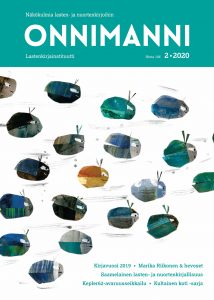In the editorial, Kaisa Laaksonen considers the impact of the corona pandemic on families’ reading habits this spring when libraries have had to close down. Not all families with children were able to read e-books or buy reading matter from online bookstores. In emergencies like these, equally accessible library services are indeed crucial.
Vuokko Hirvonen’s article about the latest Sami books for young people addresses the significance of native peoples’ access to books in their first language. In addition, Sami literature needs to strengthen the linguistic and cultural identity of young people. Contemporary Sami youth literature is not produced in a vacuum, but increasingly influenced by fantasy literature, contemporary Sami every-day life, and matters relevant to young people in general. The average age of Sami writers has gradually decreased. Most books written in Sami come from Norwegian publishers. Today, ca 10 000 Sami live in Finland.
Kaisa Laaksonen adds up the diverse range of books for children and young adults published in Finland in 2019. The Institute’s Kirjakori-exhibition comprises all in all 1255 books, including both originals in a native language and translations. During 2019, themes of societal interest and individual growth were still topical. More non-fiction books were published than ever before.
Mia Lempinen has interviewed journalist and writer Marika Riikonen, who has published two horse-themed books simultaneously: the YA novel Ravilikat (Karisto 2020) and the non-fiction book Hevostytöt (Art House 2020). The second book is based on Riikonen’s own experiences, as well as the results of a survey answered by more than 200 horse enthusiasts. Being a “horse-girl” is, foremost, not simply a matter of gender, but of experiencing a deep emotional connection with a horse. For many enthusiasts, the time spent in the stable together with a horse is an important counterweight to hectic everyday life.
Leena Laakso’s article explores the phases of an originally Estonian picturebook-series called Kultainen koti, which was published in Finland from 1938 to 1952. Since picturebooks in four colours were quite rare at the time, this series made a lasting impression on wartime child readers.
Kaisa Lange has read Timo Parvela, Bjørn Sortland and Pasi Pitkänen’s Kepler62-series (WSOY) together with her 15-year-old grandchild. This space adventure has been unusually widely read in Finland. Lange highlights the most interesting societal themes concerning the individual, friendship and power. Pasi Pitkänen has created the series’ powerful visual world.
In the Lukutikku column targeted at teachers, Lotta Luukila presents the LANU! Festival in April when books and their readers – due to the extraordinary circumstances – met online.
Translation Maria Lassén-Seger

